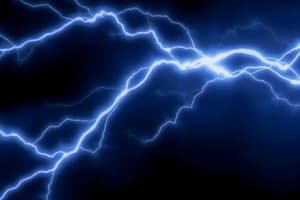Podcast
Questions and Answers
What is the main characteristic of direct current (DC)?
What is the main characteristic of direct current (DC)?
- It is primarily used for transmitting electric power.
- It has a defined frequency associated with it.
- It varies in magnitude and direction over time.
- It remains constant in magnitude and direction over time. (correct)
Which application is primarily associated with alternating current (AC)?
Which application is primarily associated with alternating current (AC)?
- Operating transistors in electronic devices.
- Charging batteries in electronic devices.
- Storing energy in batteries.
- Power transmission from generation plants to households. (correct)
What does the frequency of alternating current typically range between in most countries?
What does the frequency of alternating current typically range between in most countries?
- 30-40 Hertz.
- 20-30 Hertz.
- 70-80 Hertz.
- 50-60 Hertz. (correct)
What is the term used for the maximum value of alternating current called?
What is the term used for the maximum value of alternating current called?
How do the time period and frequency of alternating current relate to each other?
How do the time period and frequency of alternating current relate to each other?
Why is direct current (DC) not generally used in normal power transmission lines?
Why is direct current (DC) not generally used in normal power transmission lines?
What is the SI unit of electric current?
What is the SI unit of electric current?
Which of the following accurately describes direct current (DC)?
Which of the following accurately describes direct current (DC)?
How is electric current defined in scientific terms?
How is electric current defined in scientific terms?
What characterizes alternating current (AC) as opposed to direct current (DC)?
What characterizes alternating current (AC) as opposed to direct current (DC)?
In a direct current (DC) circuit, the flow of electrons occurs in which direction?
In a direct current (DC) circuit, the flow of electrons occurs in which direction?
What happens to the magnitude and direction of direct current over time?
What happens to the magnitude and direction of direct current over time?
What causes electric current to flow in solid conductors?
What causes electric current to flow in solid conductors?
Which of the following statements about electric current in liquids is true?
Which of the following statements about electric current in liquids is true?
What is needed for gases to conduct electricity?
What is needed for gases to conduct electricity?
What is the conventional direction of electric current flow in a conductor?
What is the conventional direction of electric current flow in a conductor?
What are the two types of semiconductors based on doping impurities?
What are the two types of semiconductors based on doping impurities?
What role do dissolved salts play in the conductivity of water?
What role do dissolved salts play in the conductivity of water?
Which statement correctly describes free electrons in solid conductors before a voltage is applied?
Which statement correctly describes free electrons in solid conductors before a voltage is applied?
What is a significant characteristic of current flow in semiconductors compared to metals?
What is a significant characteristic of current flow in semiconductors compared to metals?
Flashcards are hidden until you start studying
Study Notes
Electric Current Definition
- Electricity is vital for modern society, with understanding its definitions essential for applications.
- Electric current is defined as the flow of charged particles, primarily electrons, in conductors due to an applied potential difference.
- Current is quantified as the amount of charge (Coulombs) flowing per unit time (seconds), measured in Amperes (A).
Types of Electric Current
- Two main types of electric current: Direct Current (DC) and Alternating Current (AC).
Direct Current (DC)
- DC has a constant magnitude and direction, flowing from negative to positive terminal.
- A direct current circuit maintains a steady flow, depicted as a straight line in time vs. current graphs.
- Applications of DC include:
- Powering devices like watches, calculators, and clocks, which require DC for energy storage.
- Operation of electronic devices through transistors, which function on DC.
- High-Voltage Direct Current (HVDC) transmission allows efficient long-distance power transfer.
Alternating Current (AC)
- AC features time-varying magnitude and direction, oscillating multiple times per second.
- Characterized by its amplitude, time period, and frequency (standard frequency typically between 50-60 Hertz).
- Applications of AC include:
- Power transmission from generation plants to households, favored for low loss over long distances.
- Charging of batteries in devices such as cameras and mobile phones.
- Powering home appliances that require AC for operation.
Comparison of AC and DC
- AC has varying magnitude and direction with an associated frequency; DC maintains fixed magnitude and direction.
- AC is efficient for power transmission; DC is less common for transmission but useful for specific long-distance applications through HVDC.
- Many appliances convert AC to DC for internal use.
Current Flow in Conductors
- Solid conductors like metals have free electrons exhibiting random motion when not connected to a voltage source.
- Connecting to a voltage source creates a net flow of electrons toward the positive terminal, generating current.
- Current flow occurs at nearly light speed, while the drift of electrons is significantly slower.
- Conventional current is defined as flowing opposite to the electron flow.
Current in Various Substances
- Current generation mechanisms differ across substances:
Electric Current in Liquids
- In liquids, current flows due to movement of positively and negatively charged ions created by dissolved salts.
- Pure water is not a good conductor, but impurities enhance its conductivity.
Electric Current in Gases
- Gases do not conduct electricity without ionization, which creates free electrons and ions.
- Ionization involves removing electrons from atoms, enabling current flow.
Electric Current in Semiconductors
- Semiconductors, formed by doping pure materials, can carry current through holes (p-type) or electrons (n-type) depending on doping impurities.
Studying That Suits You
Use AI to generate personalized quizzes and flashcards to suit your learning preferences.




